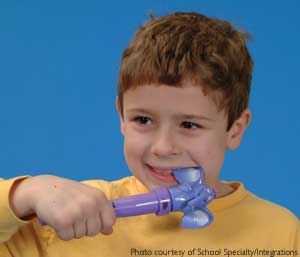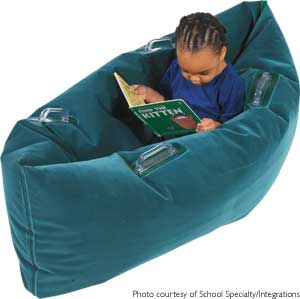Practical Solutions for Daily Challenges
Toothbrushing

Make it feel better. To desensitize gums, and help your child tolerate using a toothbrush, massage gums with a rubber finger cot, Toothette or Den-Tips (available in many drugstores), use a vibrating toothbrush, or swipe gums with a washcloth. If sensitive to noise and light, bathroom light and echoes may be too much. Avoid fluorescent lights and add sound-absorbing materials. It’s okay to use kitchen sink or a sit at a table if that makes it easier to tolerate.
Change toothpastes. If your child can’t tolerate toothpaste foam, try non-foaming toothpaste such as Orajel Toddler Training Toothpaste. Try different flavors! Your child may be perfectly happy to brush teeth with chocolate-flavored toothpaste, for example.
Make it predictable. Develop a predictable routine for when and how to brush. Help your child choose the brushing pattern. For example, she could always start with top teeth and to brush from left to right, front to back. A consistent brushing pattern will help your child learn to sequence this complex activity, help her to predict when and where she will feel various sensations (instead of feeling assaulted by the toothbrush) and help her feel proud about keeping her mouth and teeth nice and clean.
Use a timer. Kids may brush longer if it’s not YOU nagging at them to keep going. Use a regular kitchen timer or a Time Timer (see Toys & Equipment) or use toothbrushing app such as Brushout, Toothy or Disney’s Magic Timer. Also check out the fun toothbrushing videos you’ll find on YouTube.
Bathing
Switch soaps. If your child doesn’t like “slimy” soap or shampoo, try foamy soap which is also good for tactile play. You may want to avoid strong smells or find a scent your child loves.
Rinse differently. If your child avoids bathing because she hates being rinsed off, try using a large container of water since the extra weight of the water may feel soothing. Alternately, your child might be more comfortable if he feels in control of the water. In this case, provide a sprinkling can (beach or garden toy) or a hand-held shower attachment. Count down together to rinsing: “1, 2, 3, rinse.”
Keep eyes and face dry. Use a foam visor or a washrag held over the face when rinsing. This is good for a child who hates water on his face or who dislikes tilting his head back for rinsing. You might also have him dry his face immediately after washing it even if he’s still in the shower or bath.
Use a different towel. If toweling dry is a problem, experiment with softer (or harder) towel textures. You can also try pre-warming the towel in the dryer for a few minutes.
Bedtime
Calm with deep pressure. Give calming deep pressure input via a backrub or massage using long, firm strokes. Simply squeezing feet, legs, hands, and arms, can be soothing at bedtime, especially for a child who has difficulty transitioning from an aroused, wakeful state to a calm, restful state. You can also try a weighted blanket, weighted lap pad, or weighted toy, a or a cozy sensory canoe -such as the Peapod shown. Please read the latest edition of Raising a Sensory Smart Child for precautions and recommendations about using weighted blankets and other items. Blankets should never be more than 10% of body weight plus 1-2 pounds. Never use if there are respiratory, skin or other issues preventing the user from removing the blanket by peeling it aside. Do not use if person chews on blankets. Always monitor for safety.
Lights out-or not. Make sure the room is dark enough (or light enough) for your child to sleep. A small amount of light might comfort one child, while light creeping in through the curtains or under the door might disturb another. You can find portable blackout shades that attach with suction cups before you invest in more permanent ones. These can easily be packed for travel. Also try dimmable amber night lights which are frequently most soothing.
Quiet time. An auditory sensitive child may need total quiet to fall asleep. Try a white noise machine, fan, aquarium, or even a radio set on static to help block out sounds. Some kids fall asleep more easily listening to gentle music such as Mozart or special sleep-promoting CDs such as Baby Go to Sleep (800-841-4248) or Hemi-Sync sleep CDs (800-541-2488).
Haircutting
Get familiar. Visit the haircutter to check it out and watch other children get their hair trimmed (avoid the word “cut”). Familiar places are less scary.
Desensitize the scalp. Massage your child’s scalp before a haircut using your hands, handheld vibrator, or vibrating hairbrush.
Bring your own. Your child may be distressed by the plastic cape with its scratchy closure. Instead, use a soft towel and clip or an oversized shirt. Bring a t-shirt to change into right away so that she doesn’t have to wear a hair-covered shirt home.
Go kid-friendly. Go to a child-friendly haircutting salon or create your own at home with snacks and an absorbing video to watch.
Brush it off. Have the barber or stylist give the child a big soft brush or a dry washrag with baby powder on it to brush off stray hair as it is cut. Use baby powder on irritated skin afterward.
Give him time. A new haircut or hairstyle can be distracting for a child for days. Try to avoid them before a test or special event.
Clothing
Consider the softest clothing. Many kids with sensitive skin insist on super soft clothing. Many parents swear by the all-cotton clothing made by Land’s End and Hanna Andersson. Check their overstocks, check eBay.com for children’s “preconditioned” clothing, and visit local consignment stores and thrift shops (think: pre-worn = pre-softened).
Consider tightness vs. looseness. Some children are more comfortable wearing snug clothing or tight clothing worn beneath their other clothes. Try bicycle shorts, tights, “too small” t-shirts, etc.
Watch the details. When buying clothes for a tactile sensitive child, avoid scratchy nylon threads and items made of polyester blends which can pill and cause discomfort. Buy seamless socks and underwear from places such as [[smartknitkids.com](http://www.smartknitkids.com).
Shopping
Avoid shopping during peak hours. Shop during off-peak hours. When stores are at their most crowded and noisy, they can be overwhelming for a child with sensory issues, leading to tantrums and meltdowns.
Let your child push the grocery cart. Pushing provides calming sensory input. Many grocery stores have junior carts for smaller children. Have your toddler or preschooler push his stroller or pull a wagon. Add packages for extra weight.
Give your child some control and a sense of predictability. Young children can help find groceries on the shelf and match groceries to a picture list. Older kids can help you write lists, find items, pull out coupons, or check items off your to-do list.
Potty Training
Get the right seat. Some children are disturbed by the size and feel of a large toilet seat. Bring your child to the store and help her pick out a potty chair or a cushioned vinyl ring that fits onto an adult toilet seat.
Reduce the fear of flushing toilets. Some children are frightening by the sound of flushing. A sense of control helps: together, count off to the flush, for example: “1, 2, 3, FLUSH!” Make lots of noise as the toilet is flushing, shouting “hooray!”
Help them to be aware of the need to “go.” Sometimes, tight clothes provide sensory input that distracts a child from the sensation of needing to use the potty. Loose clothing such as boxer shorts may help him recognize when he has the urge to go.



Share this page: